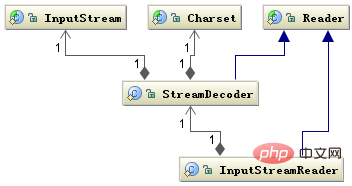Solution to Java reading Chinese garbled characters

Java reads text files (such as csv files, txt files, etc.), and when encountering Chinese, it becomes garbled. The reading code is as follows:
List<String> lines=new ArrayList<String>();
BufferedReader br = new BufferedReader(new FileReader(fileName));
String line = null;
while ((line = br.readLine()) != null) {
lines.add(line);
}
br.close();Java's I/O class processing is as shown in the figure:

The Reader class is the parent of the read characters in Java's I/O class, and the InputStream class is the parent class for reading bytes. The InputStreamReader class is the bridge that associates bytes to characters. It is responsible for processing the conversion of read bytes into characters during the I/O process, and the decoding of specific bytes into characters. It is implemented by StreamDecoder, and the Charset encoding format must be specified by the user during the decoding process of StreamDecoder. It is worth noting that if you do not specify Charset, the default character set in the local environment will be used. For example, in the Chinese environment, GBK encoding will be used.
Summary: When Java reads the data stream, you must specify the encoding method of the data stream, otherwise the default character set in the local environment will be used.
After the above analysis, the modified code is as follows:
List<String> lines=new ArrayList<String>();
BufferedReader br=new BufferedReader(new InputStreamReader(new FileInputStream(fileName),"UTF-8"));
String line = null;
while ((line = br.readLine()) != null) {
lines.add(line);
}
br.close();For more java knowledge, please pay attention to the java basic tutorial column.
The above is the detailed content of Solution to Java reading Chinese garbled characters. For more information, please follow other related articles on the PHP Chinese website!

Hot AI Tools

Undresser.AI Undress
AI-powered app for creating realistic nude photos

AI Clothes Remover
Online AI tool for removing clothes from photos.

Undress AI Tool
Undress images for free

Clothoff.io
AI clothes remover

AI Hentai Generator
Generate AI Hentai for free.

Hot Article

Hot Tools

Notepad++7.3.1
Easy-to-use and free code editor

SublimeText3 Chinese version
Chinese version, very easy to use

Zend Studio 13.0.1
Powerful PHP integrated development environment

Dreamweaver CS6
Visual web development tools

SublimeText3 Mac version
God-level code editing software (SublimeText3)

Hot Topics
 Square Root in Java
Aug 30, 2024 pm 04:26 PM
Square Root in Java
Aug 30, 2024 pm 04:26 PM
Guide to Square Root in Java. Here we discuss how Square Root works in Java with example and its code implementation respectively.
 Perfect Number in Java
Aug 30, 2024 pm 04:28 PM
Perfect Number in Java
Aug 30, 2024 pm 04:28 PM
Guide to Perfect Number in Java. Here we discuss the Definition, How to check Perfect number in Java?, examples with code implementation.
 Random Number Generator in Java
Aug 30, 2024 pm 04:27 PM
Random Number Generator in Java
Aug 30, 2024 pm 04:27 PM
Guide to Random Number Generator in Java. Here we discuss Functions in Java with examples and two different Generators with ther examples.
 Weka in Java
Aug 30, 2024 pm 04:28 PM
Weka in Java
Aug 30, 2024 pm 04:28 PM
Guide to Weka in Java. Here we discuss the Introduction, how to use weka java, the type of platform, and advantages with examples.
 Armstrong Number in Java
Aug 30, 2024 pm 04:26 PM
Armstrong Number in Java
Aug 30, 2024 pm 04:26 PM
Guide to the Armstrong Number in Java. Here we discuss an introduction to Armstrong's number in java along with some of the code.
 Smith Number in Java
Aug 30, 2024 pm 04:28 PM
Smith Number in Java
Aug 30, 2024 pm 04:28 PM
Guide to Smith Number in Java. Here we discuss the Definition, How to check smith number in Java? example with code implementation.
 Java Spring Interview Questions
Aug 30, 2024 pm 04:29 PM
Java Spring Interview Questions
Aug 30, 2024 pm 04:29 PM
In this article, we have kept the most asked Java Spring Interview Questions with their detailed answers. So that you can crack the interview.
 Break or return from Java 8 stream forEach?
Feb 07, 2025 pm 12:09 PM
Break or return from Java 8 stream forEach?
Feb 07, 2025 pm 12:09 PM
Java 8 introduces the Stream API, providing a powerful and expressive way to process data collections. However, a common question when using Stream is: How to break or return from a forEach operation? Traditional loops allow for early interruption or return, but Stream's forEach method does not directly support this method. This article will explain the reasons and explore alternative methods for implementing premature termination in Stream processing systems. Further reading: Java Stream API improvements Understand Stream forEach The forEach method is a terminal operation that performs one operation on each element in the Stream. Its design intention is






